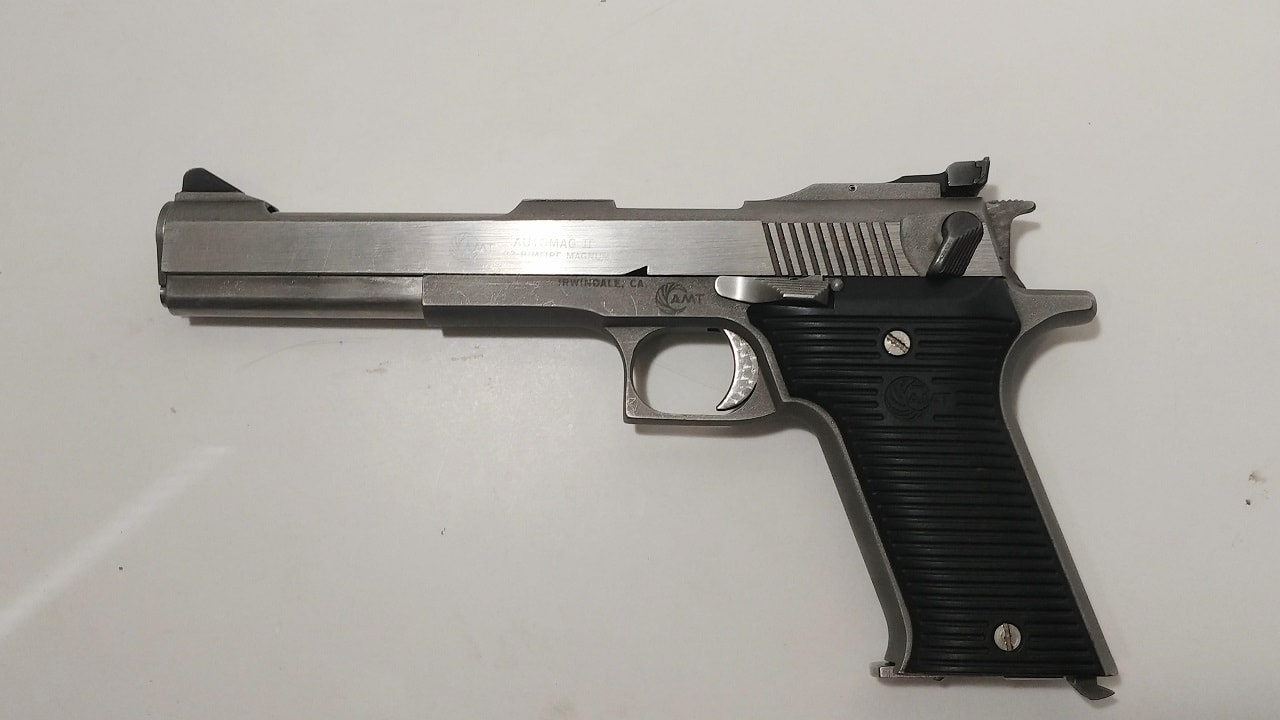AMT/High Standard .22 AutoMag II: A Five-Minute Explainer – To wine connoisseurs, the term “magnum” refers to a 1.5-liter (1.6 quart) bottle, the equivalent of two standard 750ml bottles of wine. The word magnum itself is of Latin origin, meaning “large, great, or important.” In the context of small arms ammunition therefore, as noted by Widerner’s Guns, Ammo, & Shooting Blog, “Simply put, magnum ammo contains extra propellant compared to a standard cartridge of similar size…As a result, magnum ammo will provide higher gas pressure, high-velocity projectiles, more kinetic energy and will be more powerful when compared to other cartridges of the same diameter. But a slight controversy arises in determining how much more powerful a round of ammunition must be to have the term ‘magnum’ associated with it…For now, suffice it to say that magnum ammo will approach its target with more gusto and have more destructive intent than its standard caliber version.”
Accordingly, many purists in the world of gun writers are hesitant to apply the “Magnum” label to any cartridge smaller than the original caliber to bear it, that being the .357 Magnum, which first arrived on scene back in 1935. Those nitpickers would be especially loath designate any sort of puny .22 caliber rimfire cartridge a “Magnum,” but despite their protests, we do indeed have a cartridge known as the .22 Winchester Magnum Rimfire (WMR), and moreover, a semiautomatic pistol chambered for the .22 WMR round known as the .22 AutoMag.
.22 Winchester Magnum Rimfire (WMR) History and Specifications
The .22 WMR round was developed back in 1959 – it thus bears the distinction of being the only rimfire round successfully introduced in the 20th Century – as an enlarged version of the .22 Winchester Rimfire (WRF). Though the bullet weight is very similar to the classic .22 Long Rifle (LR), the WMR is far faster and flatter shooting than the LR; most significantly – and hence that contentious “Magnum” designation — the .22 WMR has 50% more kinetic energy at 50 yards than the .22 LR has at the muzzle. Original loadout consisted of a 40-grain bullet with a muzzle velocity of 1,875 feet per second out of a rifle barrel and a muzzle energy of 324 foot-pounds (439 Joules).
AMT/High Standard AutoMag II History and Specifications
Now, when one thinks of the term “AutoMag,” more than likely he/she thinks of the original model, that being the .44 AutoMag made famous by (1) Mack Bolan in The Executioner bestselling action-adventure novel series created by the late Don Pendleton and (2) Inspector “Dirty Harry” Callahan in the 1983 film “Sudden Impact,” the fourth installation of the Dirty Harry franchise.
However, in the case of the AutoMag II, instead of being twice the gun the original was – okay, fellow 1980s movie buffs, remember Joe Piscopo’s .88 Magnum in “Johnny Dangerously?” – but rather half the gun in terms of bore size. Smaller and less powerful bore size notwithstanding, this AutoMag “sequel” (so to speak) gets the last laugh on its parent gun by having much greater commercial success and therefore remaining in uninterrupted production much longer. The AutoMag II was produced by Arcadia Machine & Tool (AMT) from 1987 to 1999, and from 1999 to 2018 by High Standard.
The pistol came with barrel length options of 4.5 inches or 6 inches, with a 3.375” bbl. Compact Model also being offered; the 4.5-incher weighed 32 ounces. Slide and frame were constructed of stainless steel, whilst the grips were synthetic. Standard magazine capacity was 9 rounds.
Personal Shooting Impressions
I got to try a rental AutoMag II at the sadly now-defunct Santa Anita Firing Range (the same range where that amusing “Have a nice day!” scene from the original “Lethal Weapon” was filmed) in Monrovia, California back in December 1989, when I was a mere 14 years old.
I hasten to add that I’d only started shooting two months earlier, and my marksmanship skills were far from fully honed, therefore my individual performance with the pistol that day was not reflective of the pistol’s true potential. What’s more, ‘twas with that young teenage hubris that I skipped the 21- and 50-foot distances and went straight to the 75-foot maximum distance that the range allowed. Suffice to say that most of the 50 rounds that I fired were way off the mark, but one proverbial “golden BB” struck dead center in the chest of the Realistic Target Company Real T04 Shooting Target, which demonstrated that the gun would do its part if the shooter did his/hers.
My other lasting recollection of the .22 AutoMag shooting experience was how damn frustrating and slippage-prone it was trying to load those super-thin cartridges into the magazine.
Want Your Own?
According to True Gun Value, “AN AMT .22 AUTOMAG II pistol is currently worth an average price of $602.12 new and $599.31 used. The 12-month average price is $602.12 new and $662.16 used.” The GunsAmerica.com website lists a 4.5-incher and a 6-incher at $495.00 and $900.00 respectively. Meanwhile, Guns International is currently advertising a 4.5” specimen for $899.95.
Christian D. Orr has 33 years of shooting experience, starting at the tender age of 14. His marksmanship accomplishments include: the Air Force Small Arms Ribbon w/one device (for M16A2 rifle and M9 pistol); Pistol Expert Ratings from U.S. Customs & Border Protection (CBP), Immigration & Customs Enforcement (ICE), and the Federal Law Enforcement Training Center (FLETC) Criminal Investigator Training Program (CITP); multiple medals and trophies via the Glock Sport Shooting Foundation (GSSF) and the Nevada Police & Fires Games (NPAF). Chris has been an NRA Certified Basic Pistol Instructor since 2011. In his spare time, he enjoys (besides shooting, obviously) dining out, cigars, Irish and British pubs, travel, USC Trojans college football, and Washington DC professional sports.

